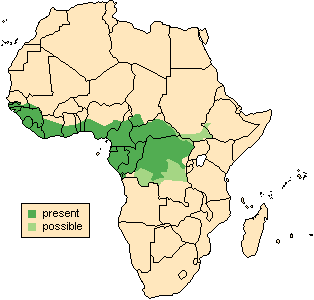![]() Return
to Artiodactyla
Return
to Artiodactyla
Classification
|
 Potamochoerus
porcus
Potamochoerus
porcus
Red river hog
![]()
Taxonomy
 |
 |
 |
Click on the pictures above for a larger view of the
photographs
|
||
General Characteristics
Body Length: 100-150 cm / 3.3-5 ft.
Shoulder Height: 55-80 cm / 1.8-2.6 ft.
Tail Length: 30-45 cm / 1-1.5 ft.
Weight: 45-120 kg / 99-264 lb.The shaggy, foxy red coat has contrasting black and white markings on the head, including a white eye ring. The leaf-shaped ears have long black and white tassels and the erectile mane which runs the length of the spine is white. Both of these features are used as defenses, as they greatly increase the perceived size of the pig when fluffed out. The snout is long, and, in males, has lengthwise ridges and warts, which are often hidden by the bushy facial hair. The body is round and is supported by short, sturdy legs. The tail is long and hairless except for the terminal tuft. The upper tusks are relatively small and almost invisible, while the lower ones are razor sharp and grow 7 cm / 3 inches long.
Ontogeny and Reproduction
Gestation Period: 120-127 days.
Young per Birth: 1-4, rarely up to 6.
Weaning: At 2-4 months.
Sexual Maturity: At 18-21 months.
Life span: 20 years.
Ecology and Behavior
Red river hogs are most active during the night, resting in a self-excavated burrow deep within impenetrable vegetation during the day. When frightened, the striped piglets crouch and "play possum". As they get older, flight becomes the more frequent response. However, when cornered or wounded, these pigs display considerable courage and frequently attack. Red river hogs are fast runners and good swimmers. They often root for tubers with their plow-like noses and can cause considerable damage to crops in a short period of time. A sounder may have a very large home range, with over 4 km / 2.4 miles between resting and feeding areas.Family group: Sounders of 2-15 females and young attended by a male.
Diet: Grasses, water plants, roots, bulbs, fruit, carrion, small animals.
Main Predators: Humans, leopard, lion, spotted hyena, python.
Distribution
Thickets, forests, savannas and swamps throughout western and central Africa.

Range Map (Redrawn from Vercammen et al., 1993)
Conservation Status
The red river hog is currently quite common and is not endangered.
Remarks
The red river hog and its eastern counterpart the bushpig were, until recently, considered to be a single species, classified under P. porcus. The name 'red river hog' refers to the foxy red colour of the coat and its habit of wallowing in ponds and streams [see below], and should not be confused with any hog living near a Red River. Potamos (Greek) a river; khoiros (Greek) a pig: they enjoy wallowing in water in hot weather. Porcus (Latin) a pig.
Literature Cited
Kingdon, J. 1997. The Kingdon Field Guide to African Mammals. Academic Press, London and New York: NaturalWorld.Nowak, R. M. [editor]. 1991. Walker's Mammals of the World (Fifth Edition). Baltimore: The Johns Hopkins University Press.
Schmidt, C. R. 1990. Pigs. In Grzimek's Encyclopedia of Mammals. Edited by S. P. Parker. New York: McGraw-Hill. Volume 5, pp. 20-47.
Vercammen, P., A. H. W. Seydack, and W. L. R. Oliver. 1993. The bush pigs (Potamochoerus porcus and P. larvatus). In Pigs, Peccaries and Hippos: Status Survey and Action Plan. Edited by W. L. R. Oliver. Gland, Switzerland: IUCN. pp. 93-101. Available online at http://iucn.org/themes/ssc/sgs/pphsg/Contents.htm
Wilson, D. E., and D. M. Reeder [editors]. 1993. Mammal Species of the World (Second Edition). Washington: Smithsonian Institution Press. Available online at http://nmnhwww.si.edu/msw/
Return to Artiodactyla

![]()
© Brent Huffman, www.ultimateungulate.com |
|
|